<< Previous | Displaying results 4101-4150 of 6769 for "" | Next >>
During the war the Japanese flooded Shanghai with anti-American and anti-British propaganda, including this image from a matchbox cover. It depicts a Japanese bomb landing in the United States heartland and knocking the stars off the U.S. flag. Shanghai, China, between 1943 and 1945. [From the USHMM special exhibition Flight and Rescue.]
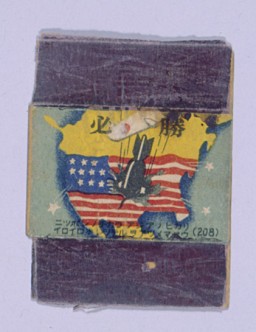

Signs excluding Jews, such as the sign shown here, were posted in public places (including parks, theaters, movie houses, and restaurants) throughout Nazi Germany. This sign states in German: "Jews are not wanted here."
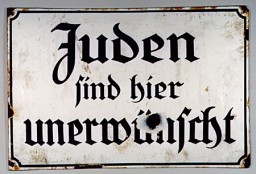
1939 flyer from the Hotel Reichshof in Hamburg, Germany. The red tag informed Jewish guests of the hotel that they were not permitted in the hotel restaurant, bar, or in the reception rooms. The hotel management required Jewish guests to take their meals in their rooms. Following the Nuremberg Laws of 1935, Jews were systematically excluded from public places in Germany.
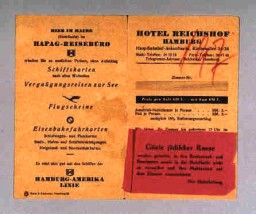
Antisemitic children's book published in 1936 in Nuremberg, Germany. The title, in German, is translated as "You Can't Trust a Fox in the Heath and a Jew on his Oath: A Picture Book for Young and Old." The cover depicts a fox in the heath and a caricature of a Jew taking an oath.
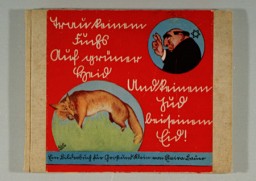
Yona Wygocka Dickmann fashioned this aluminum comb from airplane parts after the SS transferred her from Auschwitz to forced labor in an airplane factory in Freiburg, Germany, in November 1944. She used the comb as her hair, shaven in Auschwitz, began to grow back.
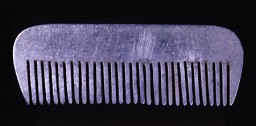
These Torah scrolls, one from a synagogue in Vienna and the other from Marburg, were desecrated during Kristallnacht (the "Night of Broken Glass"), the violent anti-Jewish pogrom of November 9 and 10, 1938. The pogrom occurred throughout Germany, which by then included both Austria and the Sudetenland region of Czechoslovakia. The scrolls pictured here were retrieved by German individuals and safeguarded until after the war.
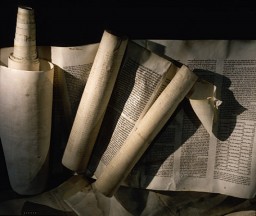
The pages photographed here are from Hebrew prayer books destroyed during the Kristallnacht ("Night of Broken Glass") pogrom of November 9 and 10, 1938. These pages were damaged by fire during the destruction of the synagogue in Bobenhausen, Germany. The Jewish community of Giessen donated them to the United States Holocaust Memorial Museum in 1989.
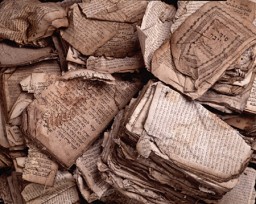
The family bible shown here belonged to Andre Trocme and contains annotations he made in preparation for his sermons. Trocme was a Protestant pastor in Le Chambon-sur-Lignon, France. During the war, he and the town's residents helped shield Jews, especially Jewish children, and others from the Germans. The operation saved thousands of refugees, including about 5,000 Jews. His handwritten inscription in French reads, in part, "Happy are those hungry and thirsty of justice; for they will be satisfied."
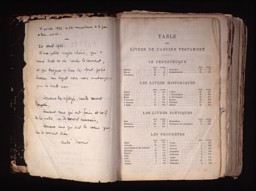
Document from the Buchenwald trial stating that both the prosecution and the defense teams agree to waive their right to make closing statements. The document is signed by the US military prosecutors (including William Denson), the defense lawyers, and the defendants. Dachau, Germany, August 8, 1947.
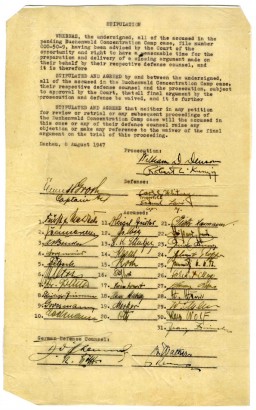
This election poster calls on Germans to vote in support of Hitler's hand-picked candidates to the Reichstag (the German parliament). The poster details Hitler's actions and reads, in part: 'In 8 months two and a quarter million Germans have work and bread again! Class warfare and its parties are eliminated! The Bolsheviks are smashed. Particularism is overcome! A Reich of order and cleanliness is established. One People. One Reich. One Leader. This is what Hitler has accomplished..."
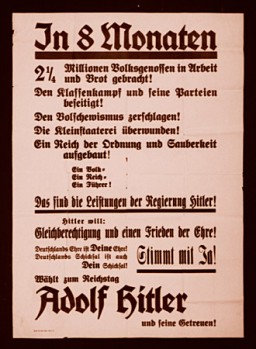
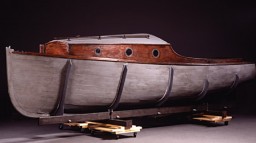
Dedication to a set of scrapbooks compiled by Bjorn Sibbern, a Danish policeman and resistance member, documenting the German occupation of Denmark. Bjorn's wife Tove was also active in the Danish resistance. After World War II, Bjorn and Tove moved to Canada and later settled in California, where Bjorn compiled five scrapbooks dedicated to the Sibbern's daughter, Lisa. The books are fully annotated in English and contain photographs, documents and three-dimensional artifacts documenting all aspects of the…
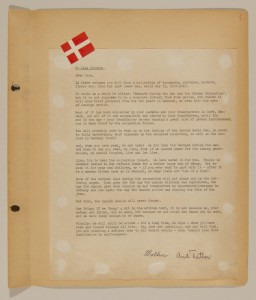
Page from volume 1 of a set of scrapbooks compiled by Bjorn Sibbern, a Danish policeman and resistance member, documenting the German occupation of Denmark. Bjorn's wife Tove was also active in the Danish resistance. After World War II, Bjorn and Tove moved to Canada and later settled in California, where Bjorn compiled five scrapbooks dedicated to the Sibbern's daughter, Lisa. The books are fully annotated in English and contain photographs, documents and three-dimensional artifacts documenting all…
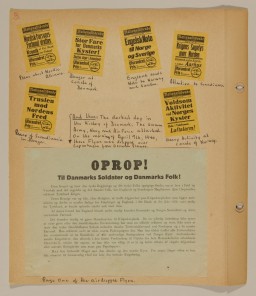
Page from volume 1 of a set of scrapbooks compiled by Bjorn Sibbern, a Danish policeman and resistance member, documenting the German occupation of Denmark. Bjorn's wife Tove was also active in the Danish resistance. After World War II, Bjorn and Tove moved to Canada and later settled in California, where Bjorn compiled five scrapbooks dedicated to the Sibbern's daughter, Lisa. The books are fully annotated in English and contain photographs, documents and three-dimensional artifacts documenting all…
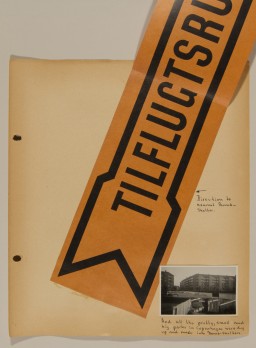
Page from volume 2 of a set of scrapbooks compiled by Bjorn Sibbern, a Danish policeman and resistance member, documenting the German occupation of Denmark. Bjorn's wife Tove was also active in the Danish resistance. After World War II, Bjorn and Tove moved to Canada and later settled in California, where Bjorn compiled five scrapbooks dedicated to the Sibbern's daughter, Lisa. The books are fully annotated in English and contain photographs, documents and three-dimensional artifacts documenting all…
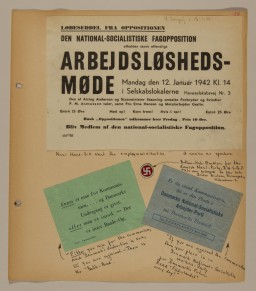
Page from volume 3 of a set of scrapbooks compiled by Bjorn Sibbern, a Danish policeman and resistance member, documenting the German occupation of Denmark. Bjorn's wife Tove was also active in the Danish resistance. After World War II, Bjorn and Tove moved to Canada and later settled in California, where Bjorn compiled five scrapbooks dedicated to the Sibbern's daughter, Lisa. The books are fully annotated in English and contain photographs, documents and three-dimensional artifacts documenting all…
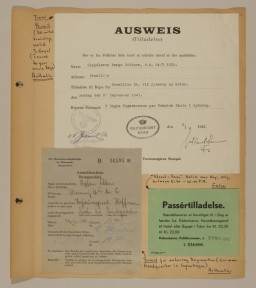
Page from volume 4 of a set of scrapbooks compiled by Bjorn Sibbern, a Danish policeman and resistance member, documenting the German occupation of Denmark. Bjorn's wife Tove was also active in the Danish resistance. After World War II, Bjorn and Tove moved to Canada and later settled in California, where Bjorn compiled five scrapbooks dedicated to the Sibbern's daughter, Lisa. The books are fully annotated in English and contain photographs, documents and three-dimensional artifacts documenting all…

Page from volume 5 of a set of scrapbooks compiled by Bjorn Sibbern, a Danish policeman and resistance member, documenting the German occupation of Denmark. Bjorn's wife Tove was also active in the Danish resistance. After World War II, Bjorn and Tove moved to Canada and later settled in California, where Bjorn compiled five scrapbooks dedicated to the Sibbern's daughter, Lisa. The books are fully annotated in English and contain photographs, documents and three-dimensional artifacts documenting all…
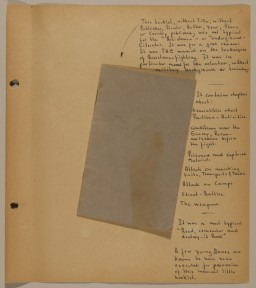
Page from volume 5 of a set of scrapbooks compiled by Bjorn Sibbern, a Danish policeman and resistance member, documenting the German occupation of Denmark. Bjorn's wife Tove was also active in the Danish resistance. After World War II, Bjorn and Tove moved to Canada and later settled in California, where Bjorn compiled five scrapbooks dedicated to the Sibbern's daughter, Lisa. The books are fully annotated in English and contain photographs, documents and three-dimensional artifacts documenting all…
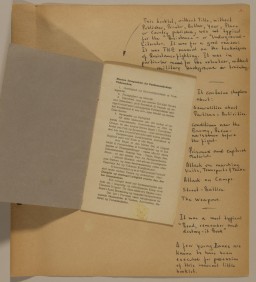
Page from volume 5 of a set of scrapbooks compiled by Bjorn Sibbern, a Danish policeman and resistance member, documenting the German occupation of Denmark. Bjorn's wife Tove was also active in the Danish resistance. After World War II, Bjorn and Tove moved to Canada and later settled in California, where Bjorn compiled five scrapbooks dedicated to the Sibbern's daughter, Lisa. The books are fully annotated in English and contain photographs, documents and three-dimensional artifacts documenting all…
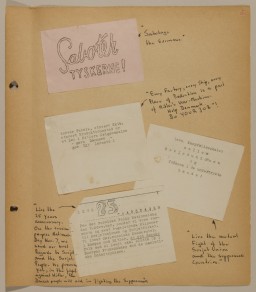
Identification tag issued to Liesel Weil by the American Friends Service Committee for her voyage to the United States on board the Mouzinho. More than 100 children sailed to New York aboard the Mouzinho, a Portuguese liner. The transport was sponsored by the American Friends Service Committee, and representatives of several Jewish organizations met the children in New York. Marseille, France, 1941.
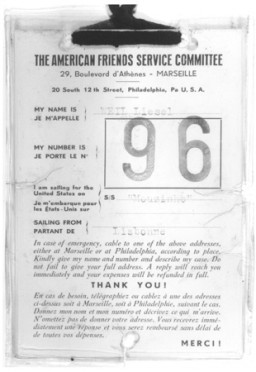
Photo album containing photographs taken by a passenger aboard the St. Louis, with a depiction of the ship on the cover. In 1939, this German ocean liner carried Jewish refugees seeking temporary refuge in Cuba. It was forced to return to Europe after Cuba refused to allow the refugees entry into the country.
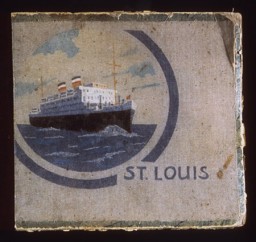
An illustration in the North-China Daily News following the arrival of a group of Jewish refugees in Shanghai, in Japanese-occupied China. August 24, 1941. [From the USHMM special exhibition Flight and Rescue.]
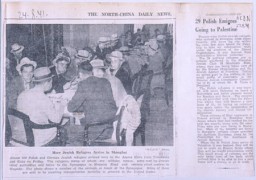
The Municipal Tourist Office in Kobe issued this folded English-language tourist guide to the city. One side shows photographs and descriptions of Kobe's historic and scenic sites and the other provides a tourist map of Kobe. Jewish refugees in Kobe used such pieces of information. Kobe, Japan, 1940-1941. [From the USHMM special exhibition Flight and Rescue.]
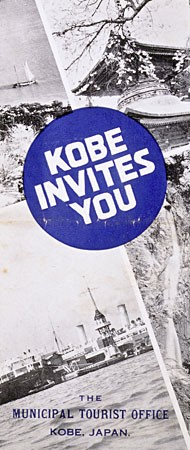
The Kobe Municipal Office issued an English-language tourist guide to Kobe and its environs. This illustration comes from the interior pages of the guide. Jewish refugees in Kobe used such pieces of information. Kobe, Japan, 1940-1941. [From the USHMM special exhibition Flight and Rescue.]
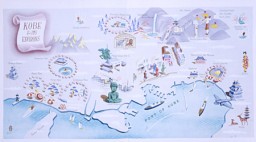
German Jewish refugees purchased this Japanese-German phrase book shortly after their arrival in Japan. Japan, 1940-1941. [From the USHMM special exhibition Flight and Rescue.]
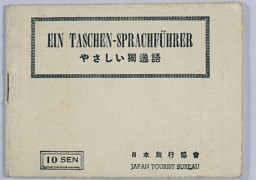
A chart of prisoner markings used in German concentration camps. Dachau, Germany, ca. 1938–1942. Beginning in 1937–1938, the SS created a system of marking prisoners in concentration camps. Sewn onto uniforms, the color-coded badges identified the reason for an individual’s incarceration, with some variation among camps. The Nazis used this chart illustrating prisoner markings in the Dachau concentration camp.
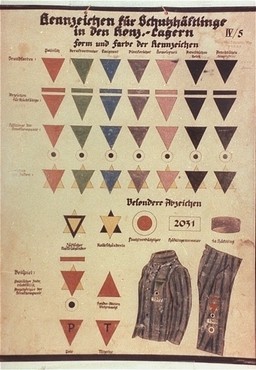
Many different kinds of railway cars were used for deportations. They varied in size and weight. The railway car on display in the United States Holocaust Memorial Museum's Permanent Exhibition is of just one type used. The dimensions of the railway car in the Museum's exhibition are as follows: Total length 31 feet 6 inches (9.6 meters); interior space for deportees 26 feet 2 inches (8 meters). Total height 14 feet (4.3 meters) from the bottom of the wheel to the highest point of the car; interior space…
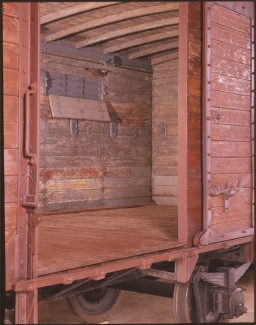
Many different kinds of railway cars were used for deportations. They varied in size and weight. The railway car on display in the United States Holocaust Memorial Museum's Permanent Exhibition is of just one type used. The dimensions of the railway car in the Museum's exhibition are as follows: Total length 31 feet 6 inches (9.6 meters); interior space for deportees 26 feet 2 inches (8 meters). Total height 14 feet (4.3 meters) from the bottom of the wheel to the highest point of the car; interior space…
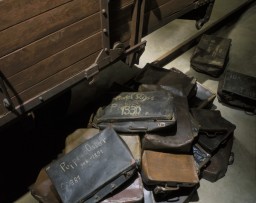
This wedding dress was made from a parachute and worn by Lilly Lax for her wedding to Ludwig Friedman in a displaced persons camp. Ludwig had promised to find fabric for a white gown, and purchased an old parachute for this purpose. Lilly hired a seamstress to make the dress in exchange for her cigarette ration. Other brides in the Celle and Belsen displaced persons camps subsequently wore the dress. Lilly and Ludwig immigrated to the United States in 1948.
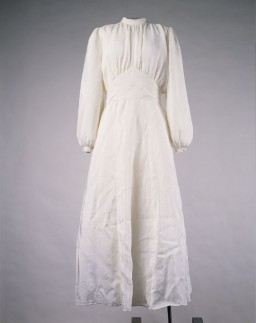
Following the Soviet occupation of Lithuania, the Lifszyc family began to search for ways to leave the country. David Lifszyc obtained a Curacao visa from the Dutch consulate. He also obtained an American visa because he was included on a list of distinguished rabbis submitted to the State Department by the Agudat Israel of America. After obtaining Soviet exit visas, the Lifszycs purchased tickets for Vladivostok on February 5, 1941. They started for Moscow, where they received Japanese transit visas. This…
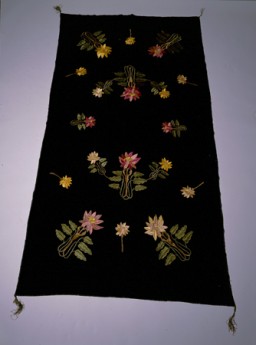
Following the Soviet occupation of Lithuania, the Lifszyc family began to search for ways to leave the country. David Lifszyc obtained a Curacao visa from the Dutch consulate. He also obtained an American visa because he was included on a list of distinguished rabbis submitted to the State Department by the Agudat Israel of America. After obtaining Soviet exit visas, the Lifszycs purchased tickets for Vladivostok on February 5, 1941. They started for Moscow, where they received Japanese transit visas. This…
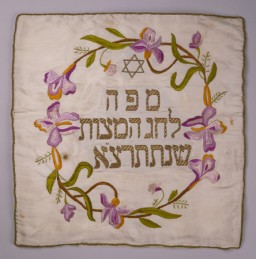
Front cover of a brochure from the Soviet travel agency Intourist, describing the amenities of the Trans-Siberian Express. Despite their anxieties, most of the Jewish refugees traveling on the train felt like tourists. [From the USHMM special exhibition Flight and Rescue.]
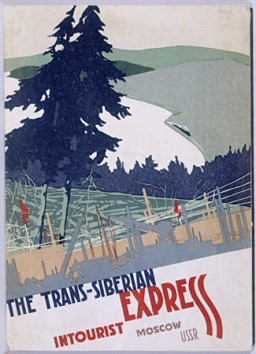
The Kobe Municipal Office issued this English-language tourist guide to Kobe and its environs. Jewish refugees in Kobe used such pieces of information. Kobe, Japan, 1940-1941. [From the USHMM special exhibition Flight and Rescue.]

The Kobe Municipal Office issued an English-language tourist guide to Kobe and its environs. The tourist map of Kobe pictured here was included with the guide. Jewish refugees in Kobe used such pieces of information. Kobe, Japan, 1940-1941. [From the USHMM special exhibition Flight and Rescue.]
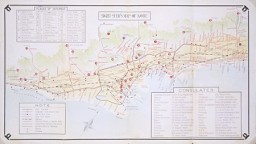
A souvenir stamp book that belonged to a Jewish refugee. The book contains multicolored stamps inscribed with dates and place names. May 1941, Kobe, Japan. [From the USHMM special exhibition Flight and Rescue.]

The table of contents from a Japanese-German phrase book purchased by German Jewish refugees shortly after their arrival in Japan. The phrase book offers useful expressions in Japanese relating to travel, hotel stays, eating, and shopping in Japan. Japan, 1940-1941. [From the USHMM special exhibition Flight and Rescue.]
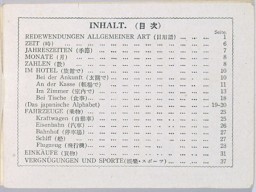
A few Polish Jewish refugees left Japan to join a small Jewish community in Harbin, Manchuria, in Japanese-occupied China. One of them carried this suitcase, covered with stickers from various shipping firms and hotels, on the journey to Harbin. China, 1940-1941. [From the USHMM special exhibition Flight and Rescue.]
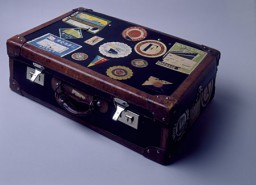
A small group of Jewish refugees left Japan to join a small Jewish community in Harbin, Manchuria, in Japanese-occupied China. This image shows the interior of a leather suitcase carried by one of them to Harbin, China, 1940-1941. [From the USHMM special exhibition Flight and Rescue.]
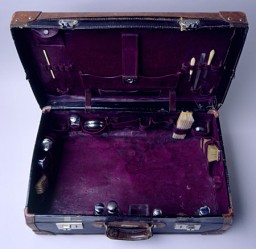
Notebook of Josef Fiszman, a refugee writer from Warsaw. He sold articles to Jewish newspapers in Shanghai and Harbin but still needed help to live from the American Jewish Joint Distribution Committee. Writing in Yiddish, Fiszman rotated the notebook in order to write from right to left (the words "Note book" thus appear to be upside down in this image). [From the USHMM special exhibition Flight and Rescue.]
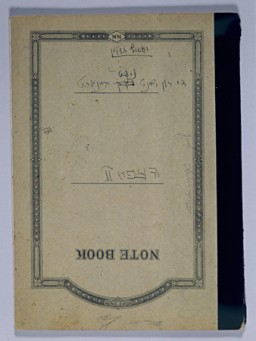
Yiddish writings of Josef Fiszman, a refugee writer from Warsaw. These are some Inside pages of a Fiszman's journal. The journal was written in Shanghai and is entitled "The Sun Never Shines At Night." [From the USHMM special exhibition Flight and Rescue.]
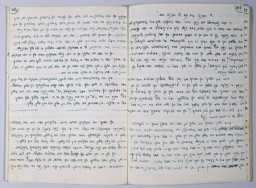
These ice skates were among the few personal belongings Hanni Sondheimer took with her on her journey from Kaunas (Kovno) to Shanghai. Hanni, who was then only a teenager, also carried a pair of red shoes and a picture of Gary Cooper. [From the USHMM special exhibition Flight and Rescue.]

Identifying armband worn by Pao Chia member. In 1942 the Japanese in Shanghai established self-policing units, Pao Chia, composed of all men, foreigners and Chinese, aged 20 to 45. In the designated area, male refugees served several hours weekly in rotating shifts as guards for buildings and ghetto entrances where they examined passes. Despite the Japanese use of the Pao Chia to help police the ghetto, it was relatively easy to leave the "designated area," which was not walled in. Individuals who did so,…
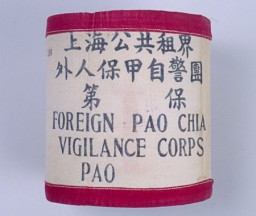
Scale used by refugees Masza Swislocki and George Lieberfreund to weigh jars of artificial honey, which they manufactured and sold in the restricted area of Shanghai. [From the USHMM special exhibition Flight and Rescue.]
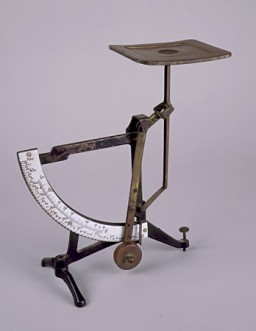
Portrait of Janek Goldstein, in pencil, by Yonia Fain. Goldstein, a friend of the artist in Shanghai, was the son of Bernard Goldstein, who was active in the Bundist underground of the Warsaw ghetto and participated in the 1943 uprising. [From the USHMM special exhibition Flight and Rescue.]
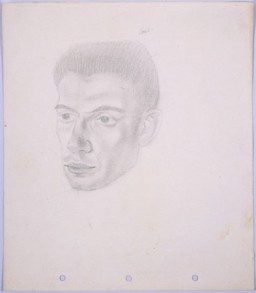
Portrait of Semek Kushner, in pencil, by Yonia Fain. Kushner's father and brother were killed in Shanghai near the end of the war during an American air raid on Hongkew. [From the USHMM special exhibition Flight and Rescue.]
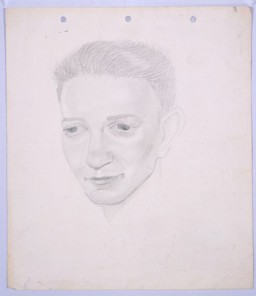
Program for an evening performance sponsored by the Shanghai Jewish Club. The program included the play "The Day of His Return" and a concert of Jewish songs. On April 27, 1943, the day of this performance featuring Warsaw Jewish actress Raya Zomina, fierce fighting continued in the Warsaw ghetto between German troops and Jews who chose to resist Nazi efforts to liquidate the ghetto. Terrifying rumors about the Holocaust reached the Jewish refugees in Shanghai, but they did not receive reliable news or…
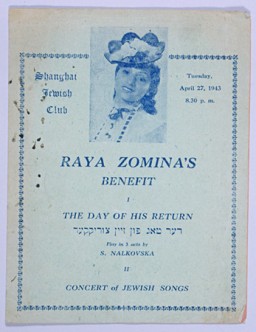
A Rosh Hashanah (Jewish New Year) greeting card. Sorle and Shalomis Gorfinkel presented this card to their parents on the occasion of Rosh Hashanah 5704, the Jewish New Year 1943. The Gorfinkel family was part of the Mir Yeshiva community in Shanghai.
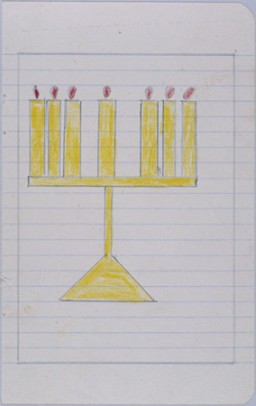
A Passover Haggadah published by rabbinical students in Shanghai in 1943. [From the USHMM special exhibition Flight and Rescue.]

We would like to thank Crown Family Philanthropies, Abe and Ida Cooper Foundation, the Claims Conference, EVZ, and BMF for supporting the ongoing work to create content and resources for the Holocaust Encyclopedia. View the list of donor acknowledgement.